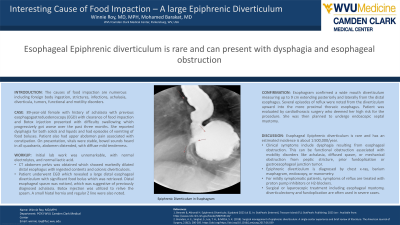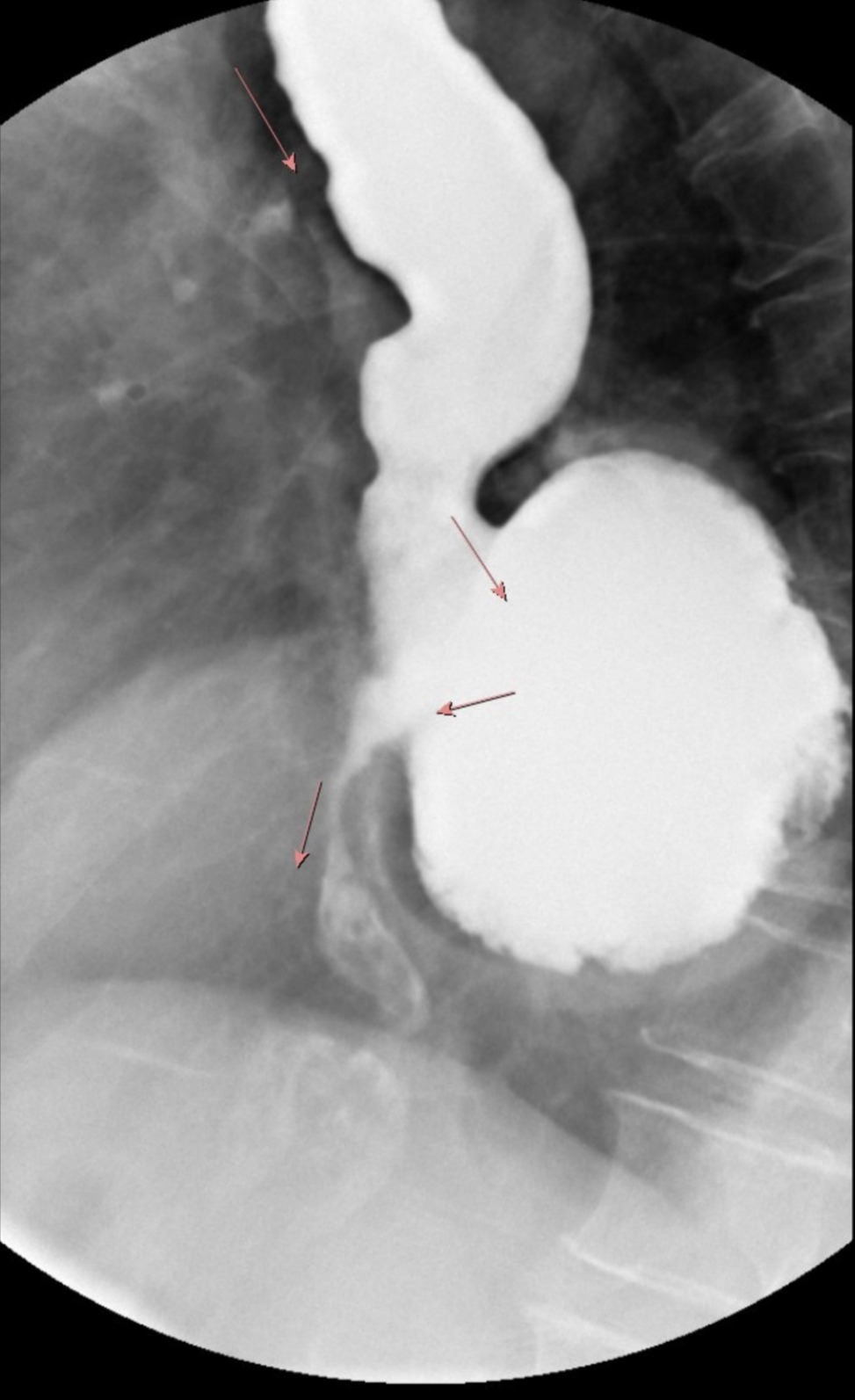Tuesday Poster Session
Category: Esophagus
P3352 - Interesting Cause of Food Impaction–A Large Epiphrenic Diverticulum
Tuesday, October 24, 2023
10:30 AM - 4:00 PM PT
Location: Exhibit Hall

Has Audio
- WR
Winnie Roy, MD, MPH
West Virginia University Camden Clark Medical Center
Parkersburg, West Virginia
Presenting Author(s)
Winnie Roy, MD, MPH, Mohamed Barakat, MD
West Virginia University Camden Clark Medical Center, Parkersburg, WV
Introduction: Causes of food impaction are numerous including foreign body ingestion, strictures, infections, achalasia, diverticula, tumors, functional and motility disorders.
Case Description/Methods: An 89-year-old female with history of achalasia with previous esophagogastroduodenoscopy (EGD) with clearance of food impaction and Botox injection presented with difficulty swallowing which progressively got worse over the past three months. She reported dysphagia for both solids and liquids and had episodes of vomiting of food boluses. Patient also had upper abdomen pain associated with constipation. On presentation, vitals were stable, bowel sounds heard in all quadrants, abdomen distended, with diffuse mild tenderness. Initial lab work was unremarkable, with normal electrolytes, and normal lactic acid. CT abdomen pelvis was obtained which showed markedly dilated distal esophagus with ingested contents and colonic diverticulosis. Patient underwent EGD which revealed a large distal esophageal diverticulum with significant food bolus which was retrieved. Distal esophagal spasm was noticed, which was suggestive of previously diagnosed achalasia. Botox injection was utilized to relive the spasm. A small hiatal hernia and regular Z line were also noted. Fluroesopagram confirmed a wide mouth diverticulum measuring up to nine centimeter extending posteriorly and laterally from the distal esophagus. Several episodes of reflux were noted from the diverticulum upward into the more proximal thoracic esophagus. Patient was evaluated by cardiothoracic surgery who deemed her high risk for the procedure. She was then planned to undergo endoscopic septal myotomy.
Discussion: Esophageal epiphrenic diverticulum is rare and has an estimated incidence is about 1:500,000/year. Clinical symptoms include dysphagia resulting from esophageal obstruction. This can be functional obstruction associated with mobility disorders like achalasia, diffused spasm, or mechanical obstruction from peptic stricture, prior fundoplication, or gastroesophageal junction tumor. Epiphrenic diverticulum is diagnosed by chest x-ray, barium esophagogram, endoscopy, or manometry. For mildly symptomatic patients, symptoms of reflux are treated with proton pump inhibitors or H2-blockers. Surgical or laparoscopic treatment including esophageal myotomy, diverticulectomy and fundoplication are often used in severe cases.
Abdollahimohammad A, Masinaeinezhad N, Firouzkouhi M. Epiphrenic esophageal diverticula. J Res Med Sci. 2014 Aug;19(8):795-7. PMID: 25422668

Disclosures:
Winnie Roy, MD, MPH, Mohamed Barakat, MD. P3352 - Interesting Cause of Food Impaction–A Large Epiphrenic Diverticulum, ACG 2023 Annual Scientific Meeting Abstracts. Vancouver, BC, Canada: American College of Gastroenterology.
West Virginia University Camden Clark Medical Center, Parkersburg, WV
Introduction: Causes of food impaction are numerous including foreign body ingestion, strictures, infections, achalasia, diverticula, tumors, functional and motility disorders.
Case Description/Methods: An 89-year-old female with history of achalasia with previous esophagogastroduodenoscopy (EGD) with clearance of food impaction and Botox injection presented with difficulty swallowing which progressively got worse over the past three months. She reported dysphagia for both solids and liquids and had episodes of vomiting of food boluses. Patient also had upper abdomen pain associated with constipation. On presentation, vitals were stable, bowel sounds heard in all quadrants, abdomen distended, with diffuse mild tenderness. Initial lab work was unremarkable, with normal electrolytes, and normal lactic acid. CT abdomen pelvis was obtained which showed markedly dilated distal esophagus with ingested contents and colonic diverticulosis. Patient underwent EGD which revealed a large distal esophageal diverticulum with significant food bolus which was retrieved. Distal esophagal spasm was noticed, which was suggestive of previously diagnosed achalasia. Botox injection was utilized to relive the spasm. A small hiatal hernia and regular Z line were also noted. Fluroesopagram confirmed a wide mouth diverticulum measuring up to nine centimeter extending posteriorly and laterally from the distal esophagus. Several episodes of reflux were noted from the diverticulum upward into the more proximal thoracic esophagus. Patient was evaluated by cardiothoracic surgery who deemed her high risk for the procedure. She was then planned to undergo endoscopic septal myotomy.
Discussion: Esophageal epiphrenic diverticulum is rare and has an estimated incidence is about 1:500,000/year. Clinical symptoms include dysphagia resulting from esophageal obstruction. This can be functional obstruction associated with mobility disorders like achalasia, diffused spasm, or mechanical obstruction from peptic stricture, prior fundoplication, or gastroesophageal junction tumor. Epiphrenic diverticulum is diagnosed by chest x-ray, barium esophagogram, endoscopy, or manometry. For mildly symptomatic patients, symptoms of reflux are treated with proton pump inhibitors or H2-blockers. Surgical or laparoscopic treatment including esophageal myotomy, diverticulectomy and fundoplication are often used in severe cases.
Abdollahimohammad A, Masinaeinezhad N, Firouzkouhi M. Epiphrenic esophageal diverticula. J Res Med Sci. 2014 Aug;19(8):795-7. PMID: 25422668

Figure: Epiphrenic Diverticulum
Disclosures:
Winnie Roy indicated no relevant financial relationships.
Mohamed Barakat indicated no relevant financial relationships.
Winnie Roy, MD, MPH, Mohamed Barakat, MD. P3352 - Interesting Cause of Food Impaction–A Large Epiphrenic Diverticulum, ACG 2023 Annual Scientific Meeting Abstracts. Vancouver, BC, Canada: American College of Gastroenterology.
